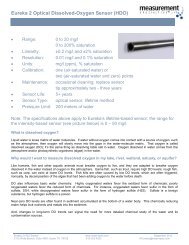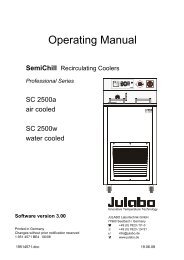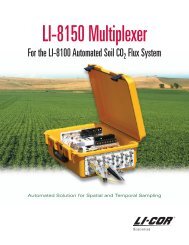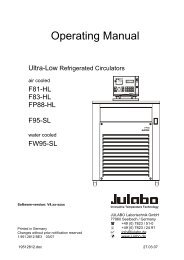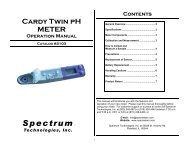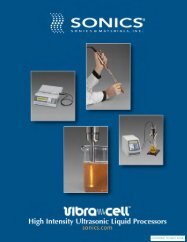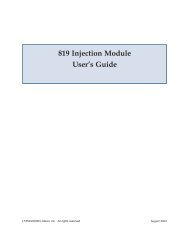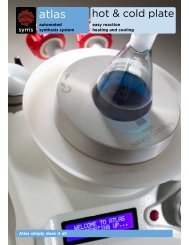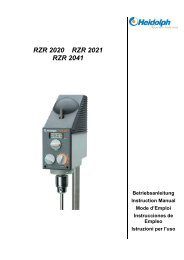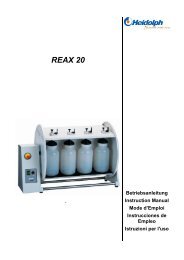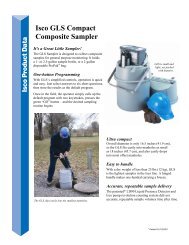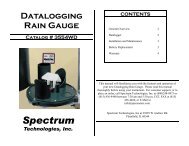Sample Preparation Laser Particle Sizer "analysette 22"
Sample Preparation Laser Particle Sizer "analysette 22"
Sample Preparation Laser Particle Sizer "analysette 22"
You also want an ePaper? Increase the reach of your titles
YUMPU automatically turns print PDFs into web optimized ePapers that Google loves.
<strong>Sample</strong> <strong>Preparation</strong><br />
for the<br />
<strong>Laser</strong> <strong>Particle</strong> <strong>Sizer</strong><br />
"<strong>analysette</strong> 22"<br />
Proper Sampling<br />
<strong>Sample</strong> Dividing<br />
<strong>Sample</strong> <strong>Preparation</strong><br />
Dispersion<br />
Tips and Tricks<br />
Materials and Suitable Measurement Liquids<br />
U.Gerber<br />
August 2004
Proper Sampling<br />
It is always surprising how the market for high-precision, fully automatic analysis<br />
equipment is constantly growing, but so little importance is placed on the sampling<br />
techniques and preparation, which are at least as important as the actual equipment.<br />
One of the most frequent errors encountered in an analysis occurs already when the<br />
sample is obtained and is introduced into the analysis process from the very beginning.<br />
Process technicians are consistently amazed at how frivolously samples are taken and<br />
how easily the analyses results obtained are accepted without question.<br />
Deviations in repeated measurements often give rise to doubts about the measurement<br />
equipment, but the cause of the error lies deeper: inhomogenous sampling.<br />
The results are only reproducible if the analysed sample is highly representative of the<br />
material being tested, in other words, if the sample taken is equivalent to the entire<br />
material batch.<br />
1. <strong>Sample</strong> Dividing<br />
The sample for the laser particle sizer (approx. 200 mg - 1g) should correspond to<br />
the entire quantity of source material with regard to particle type and distribution.<br />
The rotary cone sample divider "laborette 27" is very well suited for dividing of dry<br />
laboratory samples or suspensions because various dividing heads with different<br />
division ratios can be selected (see special printing of Aufbereitungs-Technik,<br />
Volume 9 / 1996). Depending on the dividing head used, up to 3000 divisions per<br />
minute can be achieved.<br />
Possible divisions: 1:8, 1:10 and 1:30<br />
Example: An existing laboratory sample of 50 ml (g) or 100 ml (g) could first be<br />
divided with the installed dividing head 1:10 and then with the dividing head 1:30 so<br />
that the quantity of 200 - 400 mg required for the laser particle sizer is available.<br />
This representative sample must be deagglomerated.<br />
-2-
2. <strong>Sample</strong> <strong>Preparation</strong><br />
Preliminary tests must be performed to determine the manner in which the sample<br />
material can be wetted and dispersed.<br />
The liquid should wet the solid as spontaneously and completely as possible!<br />
The additional ultrasound assistance with the highest possible output generally<br />
reduces the time required for dispersion significantly.<br />
• The solid particles should be present in the suspension individually - free of<br />
agglomerates.<br />
• The dispersed condition must be stable throughout the entire measurement,<br />
coagulation / flocculent precipitation may not occur.<br />
The coagulation of a suspension can be recognised based on a light, greasy<br />
sediment that floats in cloud-like form as a 2nd phase or layer in the sample glass<br />
when moved lightly.<br />
• Floating to the surface of the liquid indicates sample material that is not properly<br />
wetted, meaning that the amount of any dispersing agent added (tensides or wetting<br />
/ interlacing agents or salts) is too low.<br />
• The sample may not be destroyed or broken during the dispersion. For thin, plateletshaped<br />
materials such as mica, terra alba, clay and inorg. salts, this is particularly<br />
important.<br />
In such cases, it is recommended that a small quanitity of the sample be mixed into<br />
a paste on a slide with some liquid and wetting agent. The grain spectrum and the<br />
maximum grain size can be identified under a microscope.<br />
After completing the dispersion process, a micropscope is also used to check<br />
whether the coarse grains are still present or were destroyed.<br />
• The suspension / measurement liquid must always have a lower or the same<br />
specific gravity (density) than the solid to be measured.<br />
• The sample may not solvate, dissolve or swell!<br />
-3-
2.1 Dispersion<br />
Easy samples that submerse directly in water without significant effort and do not<br />
have a large fine portion are added to the dispersing unit as a solid portion by<br />
portion using a spatula and can be measured reproducibly after a brief ultrasound<br />
exposure / dispersion (30 - 60 s).<br />
If the double measurement performed exhibits excessively large differences in the<br />
grain size distribution, this may have several reasons:<br />
• pump speed is too low - coarse material is settling out<br />
• stirrer speed is too high - air bubbles form<br />
• dispersion time is too short<br />
• increasing fine portion - longer ultrasound exposure required<br />
• - add dispersion agent<br />
• - adhesion of fine particles to the cell glass<br />
• - blockage by coarse grain > 1.5 mm<br />
• - coarse material settled out: spec. gravity too high<br />
• curve appears too coarse - sample is swelling or flaking out<br />
• - sample is agglomerated<br />
• - sample is magnetic<br />
• decreasing coarse and fine range - sample dissolves<br />
• - beam absorption decreases<br />
In addition, inaccurate measurements can result from pinched or kinked tube<br />
connections (due to movement of the measurement cell for multi-range<br />
measurements).<br />
-4-
Difficult to disperse samples may exhibit the following properties: static charge (e.g.<br />
for polymers), adhesion or cohesion forces – samples tend to stick/clump (e.g.<br />
clays, soil samples, terra alba), magnetism, hydrophobic properties – waterrepelling<br />
molecular components (e.g. pharmaceuticals, medications, toner, graphite,<br />
titanium dioxide), coagulation (e.g. clays, terra alba, chalk, gypsum).<br />
a) Static charge or hydrophobic properties:<br />
A spatula portion of the material should be placed in a small 50 ml Erlenmeyer flask<br />
and then first wet with 1 (to 2) drops of a wetting agent (tenside) and mixed into a<br />
paste until the sample is completely wetted! Then add water drop by drop and stir<br />
some more. The approx. 20 - 30 ml suspension is dispersed in the ultrasound bath.<br />
If the sample is already located in the dispersion unit and floats to the surface, the<br />
sample can be wetted as follows:<br />
with a glass rod or the tip of a spatula, a small drop of a wetting agent (e.g. Imbentin<br />
(SG/45/AG), Teepol or Pril) is placed on / touched against the liquid surface and<br />
distributed. It can immediately be seen that the skin formed on the surface breaks<br />
open and the fine portion enters the suspension.<br />
b) Adhesion forces:<br />
The surface adhesion of the particles. These surface forces can be reduced by<br />
creating adsorption layers of tensides or macromolecules at the solid/liquid phase<br />
borders. One refers here to the coating, shielding or masking of the solid or to<br />
wetting.<br />
For this reason, sodium diphosphate (sodium pyrophosphate: Na 4 P 2 O 7 ) or polysalts<br />
in concentrations of approx. 0.5-1% are generally used.<br />
c) Cohesion forces and magnetism:<br />
The effects of attractive forces between atoms or molecules of a body are referred to<br />
as cohesion force or polarity or as magnetic properties. The magnetic properties are<br />
difficult to eliminate: either one uses a highly viscous liquid such as ethylene glycol<br />
or glycerin/water mixtures for low magnetism or one heats the sample to over 100°C.<br />
However this is hardly possible in the laboratory and rarely performed. For this<br />
reason, such materials with strong magnetism are not suited for particle size<br />
analysis.<br />
-5-
d) Coagulation:<br />
This is the flocculent precipitation of a sample resulting from colloidal particles<br />
balling together in a suspension. This can occur when the quantity of solids is too<br />
large or if the pH range is unfavourable. By adding a few drops of dilute acid (e.g.<br />
hydrochloric acid) before adding the sample (!!) for the acidic range or diluted bases<br />
(e.g. caustic soda hydrated, ammonia or soda solution) in the alkaline range, the pH<br />
value can be decreased or increased in order to counteract the reaction of the<br />
sample (e.g. for chalks, terra alba, slaked lime and clay).<br />
2.2 Tips and Tricks<br />
The larger the fine portion of a sample is, the greater the effort required for<br />
dispersion. If required, ultrasound exposure should take place for several minutes in<br />
the external ultrasound bath "laborette 17".<br />
We recommend placing a spatula tip's worth of sample (approx. 0.5 - 1 g) in a 50 ml<br />
Erlenmeyer flask and, for easily wetted substances, adding approx. 20 - 30 ml of<br />
the measurement fluid + the dissolved / mixed dispersion aid/tensides. When using<br />
tensides, we recommend low-foam tensides, such as Imbentin SG/45/AG (from the<br />
company Dr. W. Kolb, CH-Hedingen or STS Tensid Service GmbH<br />
D-68649 Gross-Rohrheim).<br />
After shaking briefly, hang the Erlenmeyer flask on a laboratory clamp in the<br />
ultrasound bath in such a way that the interior liquid level lies below the liquid<br />
surface of the ultrasound bath.<br />
After the deagglomeration time determined in preliminary tests, the suspension<br />
quantity required for the measurement is added to the dispersion unit of the laser<br />
with a pipette (while agitating).<br />
If the required quantity of solid is precisely known, the complete contents can be<br />
transferred with a wash bottle by weighing into the Erlenmeyer flask and<br />
subsequent dispersion; this means that no demixing can take place when taking the<br />
sample with a pipette.<br />
-6-
Difficult samples, such as fly ash, sulphur, coal, polymers or pigments can be<br />
quickly dispersed even in water with a few small tricks.<br />
The laid out sample is combined with one drop of tenside and mixed to a paste with<br />
a glass rod or spatula after adding one to two drops of water. Due to the relatively<br />
high tenside quantity compared to the water, the cavitation is reduced and the<br />
analysis sample is very quickly wetted.<br />
After adding a few drops of water while stirring, one can check whether particles<br />
that are not yet wetted are floating on the surface of the liquid.<br />
Then dilute the suspension to approx. 20 - 30 ml and deagglomerate it in the<br />
ultrasound bath.<br />
When using simple tensides like flushing agent (e.g Pril), it often happens that<br />
"foam" arises while mixing to a paste and mixing into the sample; this foam floats on<br />
the surface after dispersing and is transferred to the dispersing unit.<br />
If the stirrer intensity is too great, the foam is pulled into the measurement circuit<br />
and "coarse grains" are measured that are not present.<br />
To avoid this "mis-measurement", it is possible to destroy the "foam" in the<br />
Erlenmeyer flask: with a glass rod the tip of which is dipped in n-butanol such that<br />
the glass rod is only moistened but no drop can be seen.<br />
A light contact with the foam surface causes it to collapse away and the suspension<br />
can be analysed for particle size without difficulty.<br />
Another option for substances that are difficult to wet is adding 2 to 3 drops of (e.g.<br />
alcohol (ethanol)) to the dry laboratory sample, which immediately soaks up the<br />
alcohol like a sponge. Water + wetting agent can now be added and the sample<br />
dispersed accordingly.<br />
-7-
The user who works with the "liquid dispersing unit for small quantities“ naturally<br />
also has the option of using alcohols, alkanes, high-boiling-point benzines or other<br />
organic liquids.<br />
It should be mentioned here that the liquid dispersing unit for small quantities is not<br />
explosion-safe -select appropriate liquids - and should only be operated with good<br />
ventilation.<br />
Changing the measurement fluid from alcohol, for example, to other liquids is<br />
relatively simple because many organic liquids mix well together.<br />
The compatibility of the solvent with the the connection tubes should also be<br />
considered. The sealing rings in the measurement cell and the connection tubes are<br />
made of Viton.<br />
Some liquids that cannot be used are: acetone (ketones) and paint thinner.<br />
The resistance list available from the hose manufacturers contains a rating of the<br />
chemical reistsnace to various operating media (liquids) for the most common<br />
elastomers.<br />
After completing a measurement with the laser particle sizer "<strong>analysette</strong> 22", one<br />
should absolutely practice the habit of rinsing out the measurement system<br />
immediately, to prevent unnecessary "depositing" or "sticking" of particles in the<br />
measurement circuit and, above all, on the measurement cell.<br />
An "intermediate rinsing" with a tenside solution is very helpful for this.<br />
Tap water or water with a high lime content can lead to deposits on the<br />
measurement cell. One should either switch to distilled water or it is necessary to<br />
clean the measurement cell from time to time.<br />
Rinsing with an approximately 10% hydrochloric acid will remove the lime coating<br />
after just a few minutes. Then rinse twice with normal water.<br />
-8-




